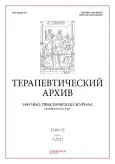Analysis of the effectiveness of multiple myeloma treatment based on the clinical experience of European countries
- Authors: Ptushkin V.V.1,2,3, Mueller M.4,5
-
Affiliations:
- Pirogov Russian National Research Medical University
- Rogachev National Medical Research Center of Pediatric Hematology, Oncology and Immunology
- Botkin City Clinical Hospital
- University of Mannheim
- Analytical company IQVIA
- Issue: Vol 93, No 4 (2021)
- Pages: 404-414
- Section: Original articles
- URL: https://journals.rcsi.science/0040-3660/article/view/71206
- DOI: https://doi.org/10.26442/00403660.2021.04.200682
- ID: 71206
Cite item
Full Text
Abstract
Aim. The main aim of this study was to model the effectiveness of multiple myeloma (MM) therapy using machine learning, which was based on the analysis of various methods of MM treatment, a number of prognostic factors and their results in the daily routine clinical practice of medical centers in European countries.
Materials and methods. The present study was retrospective, non-interventional, multicenter. A structured database of MM patients provided by the Oncology Information service (O.I.s.) was used for the study. Registration took place in medical institutions in eight countries: Austria, Belgium, Switzerland, Germany, Spain, France, Greece and Great Britain.
Results. In total, 57% of men and 43% of women were analyzed in the base of 6074 patients with MM. The median age was 71 years. The median follow-up time along the lines was 387 days. High-risk cytogenetics are represented in 15% of cases. The efficacy endpoint was the best response to each line of therapy, as measured by time to death (TTD) as an indirect indicator of overall survival and time to next treatment (TTNT) as an indirect indicator of progression-free survival. The median TTD and TTNT were 730 and 399 days respectively. After a multi-step selection process, characteristics with the greatest importance for the therapy prognosis were selected: age at the beginning of therapy, line of therapy, time after MM verification, ECOG (Eastern Cooperative Oncology Group), cytogenetic risk, transplant eligibible or not, TTNT after the previous line of therapy, therapy regimen.
Discussion. To continue the study it is necessary to analyze literature data and compare with real practice. Also analysis and comparison with Russian data on the treatment of patients with MM is required.
Conclusion. The analysis of the presented data provides a basis for modeling a tool for assessing the effectiveness of MM therapy (prognosis of TTD and TTNT) for each patient, based on a number of prognostic factors and the results of routine clinical practice in various medical centers in European countries.
Full Text
##article.viewOnOriginalSite##About the authors
Vadim V. Ptushkin
Pirogov Russian National Research Medical University; Rogachev National Medical Research Center of Pediatric Hematology, Oncology and Immunology; Botkin City Clinical Hospital
Author for correspondence.
Email: vadimvadim@inbox.ru
ORCID iD: 0000-0002-9368-6050
д.м.н., проф. каф. онкологии, гематологии и лучевой терапии ФГАОУ ВО «РНИМУ им. Н.И. Пирогова», зав. отд. инновационных методов лечения подростков и взрослых ФГБУ «НМИЦ ДГОИ им. Дмитрия Рогачева», гл. внештат. специалист-гематолог Департамента здравоохранения г. Москвы, зам. глав. врача по гематологии ГБУЗ «ГКБ им. С.П. Боткина»
Russian Federation, MoscowMario Mueller
University of Mannheim; Analytical company IQVIA
Email: mario.mueller@iqvia.com
ORCID iD: 0000-0002-3528-5208
магистр, специализация «Многомерный статистический анализ», Университет г. Манхайм, зам. дир. по обработке и углубленному анализу данных, Аналитическая компания IQVIA
Germany, Mannheim, Frankfurt am MainReferences
- Злокачественные новообразования в России в 2017 году (заболеваемость и смертность). Под ред. А.Д. Каприна, В.В. Старинского, Г.В. Петровой. Moscow, МНИОИ им. П.А. Герцена – филиал ФГБУ «НМИЦ радиологии» Минздрава России, 2018 [Malignant neoplasms in Russia in 2017 (morbidity and mortality). Ed. AD Kaprin, VV Starinsky, GV Petrova. M.: P.A. Herzen MNIOI – branch of the Federal State Budgetary Institution “National Medical Research Center of Radiology” of the Ministry of Health of Russia, 2018 (In Russ.)].
- Виноградова О.Ю., Птушкин В.В., Черников М.В., и др. Эпидемиология множественной миеломы в городе Москва. Терапевтический архив. 2019;91(7):83-92 [Vinogradova OY, Ptushkin VV, Chernikov MV, et al. Epidemiology of multiple myeloma in city Moscow. Terapevticheskii Arkhiv (Ter. Arkh). 2019;91(7):83-92 (In Russ.)]. doi: 10.26442/00403660.2019.07.000305
- Larocca A, Palumbo A. Optimizing treatment for elderly patients with newly diagnosed multiple myeloma: a personalized approach. J Clin Oncol. 2016;34:3600-4. doi: 10.1200/JCO.2016.68.6113
- Palumbo A, Mina R. Management of older adults with multiple. Blood Rev. 2013; 27:133-42. doi: 10.1016/j.blre.2013.04.001
- Singh H, Beaver JA, Kim G, Pazdur R. Enrollment of older adults on oncology trials: an FDA perspective. J Geriatr Oncol. 2017;8:149-50.
- Hari P, Romanus D, Luptakova K, et al. The impact of age and comorbidities on practice patterns and outcomes in patients with relapsed/refractory multiple myeloma in the era of novel therapies. J Geriatr Oncol. 2018;2:138-44. doi: 10.1016/j.jgo.2017.09.007
- Chari A, Mezzi K, Zhu S, et al. Incidence and risk of hypertension in patients newly treated for multiple myeloma: a retrospective cohort study. BMC Cancer. 2016;16:912. doi: 10.1186/s12885-016-2955-0
- Kistler KD, Kalman J, Sahni G, et al. Incidence and risk of cardiac events in patients with previously treated multiple myeloma versus matched patients without multiple myeloma: an observational, retrospective, cohort study. Clin Lymphoma Myeloma Leuk. 2017;17:89-96. doi: 10.1016/j.clml.2016.11.009
- Talarico L, Chen G, Pazdar R. Enrollment of elderly patients in clinical trials for cancer drug registration: a 7-year experience by the US Food and Drug Administration. J Clin Oncol. 2004;22:4626-31. doi: 10.1200/JCO.2004.02.175
- Usmani S, Ahmadi T, Ng Y, et al. Analysis of real-world data on overall survival in MM patients with 3 prior lines of therapy including a PI and an IMID, or double refractory to a PI and an IMID. Oncologist. 2016;21:1-7.
- Chen Y, Jia Z, Mercola D, Xie X. A Gradient Boosting Algorithm for Survival Analysis via Direct Optimization of Concordance Index. Comput Math Methods Med. 2013;2013:873595. doi: 10.1155/2013/873595
- Kvamme H, Borgan Ø, Scheel I. Time-to-event prediction with neural networks and Cox regression. JMLR. 2019;20(129):1-30.
- Katzman J, Shaham U, Cloninger A, et al. Deepsurv: personalized treatment recommender system using a Cox proportional hazards deep neural network. BMC Med Res Methodol. 2018;18(1):18-24. doi: 10.1186/s12874-018-0482-1
Supplementary files










